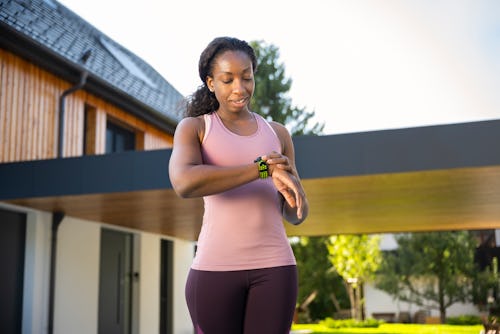Fitness
What Muscles Does Walking Work? Trainers Explain
Not such a silly little workout, is it!

When you think about strength training, walking might not spring to mind. But whether you go on a casual stroll, or power your way through an hour long walk, you will come out the other side with stronger muscles.
Before we get into all the muscles walking works, let’s take a moment to revel in all of its other benefits. According to trainer Johanna Devries, whose YouTube channel Growwithjo features lots of walking workouts, walking on a regular basis improves your cardiovascular endurance and helps prevent disease. It also ups your energy levels and improves your mood — even if you just walk for 10 minutes. And the gentle impact can help strengthen your bones while going easy on your joints.
Walking is a great supplement to other forms of exercise, too, says Brett Larkin, a yoga teacher and founder of Uplifted Yoga, who goes for walks six days a week. Walking is an ideal way to cool down after a sweaty workout and it’s perfect for active rest days, but Larkin says it also stands on its own if you want a low-impact bodyweight exercise that can be done anytime and anywhere.
To get in on the action, go for a walk outside or hop on a treadmill. “Both are effective,” Devries says. “If you are planning on walking outside on concrete, though, I would suggest getting a good pair of supportive shoes.” The benefit of using a treadmill is that it’s easier on the joints, but the right walking shoes can protect you, too. With that in mind, here’s a list of the muscles you’ll hit.
All The Muscles Walking Works
Walking will target multiple muscle groups, even if you take it easy. But if you want to use walking for strength training and conditioning purposes, Devries suggests lacing up your sneakers at least three days a week and walking at a moderate intensity for 30 to 40 minutes. “Make sure that each time you walk, you feel at least slightly challenged,” she says.
Core & Upper Body
Walking is technically a full-body exercise, Devries says, because of the way it calls on multiple muscle groups to help power you forward. It strengthens your core, especially if you engage your abs. And it also targets your upper body as you pump your arms. To work your biceps and triceps even more, Larkin suggests holding a set of three pound weights as you go.
Calves
You’ll feel the effects of walking in your calves, too. According to Devries, that’s because the calf muscles move through flexion and extension. This motion is also why it’s so important to stretch after a stroll to help prevent soreness.
Glutes
Your glute muscles also get a workout, especially if you mosey uphill. “If you have a hilly path or are walking on an incline on the treadmill, you can expect to be sore in your rear the next day,” Devries says.
In fact, you might want to seek out rolling streets or trails with rougher terrain — like hills and rocks — to get an extra intense workout, Larkin says. If that isn’t possible, wear a set of ankle weights for added resistance.
Quads
Walking on an incline also hits the quadriceps, whether you’re on a treadmill or hiking up steep streets. “As the incline increases, the force of gravity makes it harder to step forward,” says Devries. “This puts tension on the quadriceps muscles, and you have to press down into your heel to transfer the weight to the glutes and hamstrings.” The result? Super strong quads.
Hamstrings
If you walk downhill, or put a lot of power into your steps on a flat surface, you can effectively strengthen the hamstring muscles. “To lift your foot off the ground, you have to lift your knees and bring your heels off the ground,” Devries explains. The supporting muscles of this movement are the hamstrings, so get ready to feel extra power down the backs of your legs, too.
Studies referenced:
Benedetti, M. G., Furlini, G., Zati, A., & Letizia Mauro, G. (2018). The Effectiveness of Physical Exercise on Bone Density in Osteoporotic Patients. BioMed research international, 2018, 4840531. https://doi.org/10.1155/2018/4840531.
Edwards MK, Loprinzi PD. Experimental effects of brief, single bouts of walking and meditation on mood profile in young adults. Health Promot Perspect. 2018 Jul 7;8(3):171-178. doi: 10.15171/hpp.2018.23. PMID: 30087839; PMCID: PMC6064756.
Ellis RG, Sumner BJ, Kram R. Muscle contributions to propulsion and braking during walking and running: insight from external force perturbations. Gait Posture. 2014 Sep;40(4):594-9. doi: 10.1016/j.gaitpost.2014.07.002. Epub 2014 Jul 10. PMID: 25096545.
Kuhtz-Buschbeck JP, Jing B. Activity of upper limb muscles during human walking. J Electromyogr Kinesiol. 2012 Apr;22(2):199-206. doi: 10.1016/j.jelekin.2011.08.014. Epub 2011 Sep 25. PMID: 21945656.
Murtagh, E. M., Murphy, M. H., & Boone-Heinonen, J. (2010). Walking: the first steps in cardiovascular disease prevention. Current opinion in cardiology, 25(5), 490–496. https://doi.org/10.1097/HCO.0b013e32833ce972.
Sources:
Johanna Devries, trainer, owner of YouTube channel Growwithjo
Brett Larkin, yoga teacher and founder of Uplifted Yoga